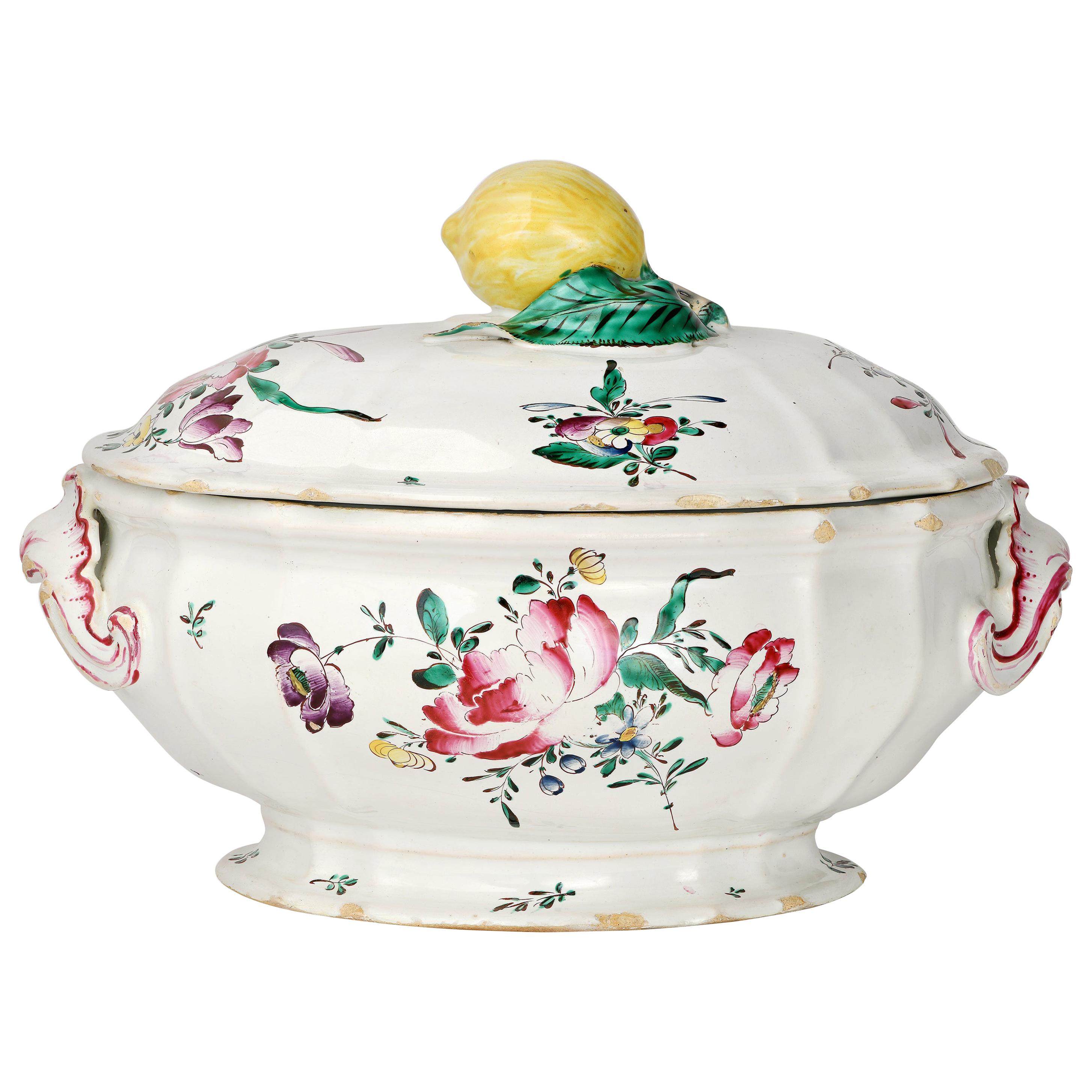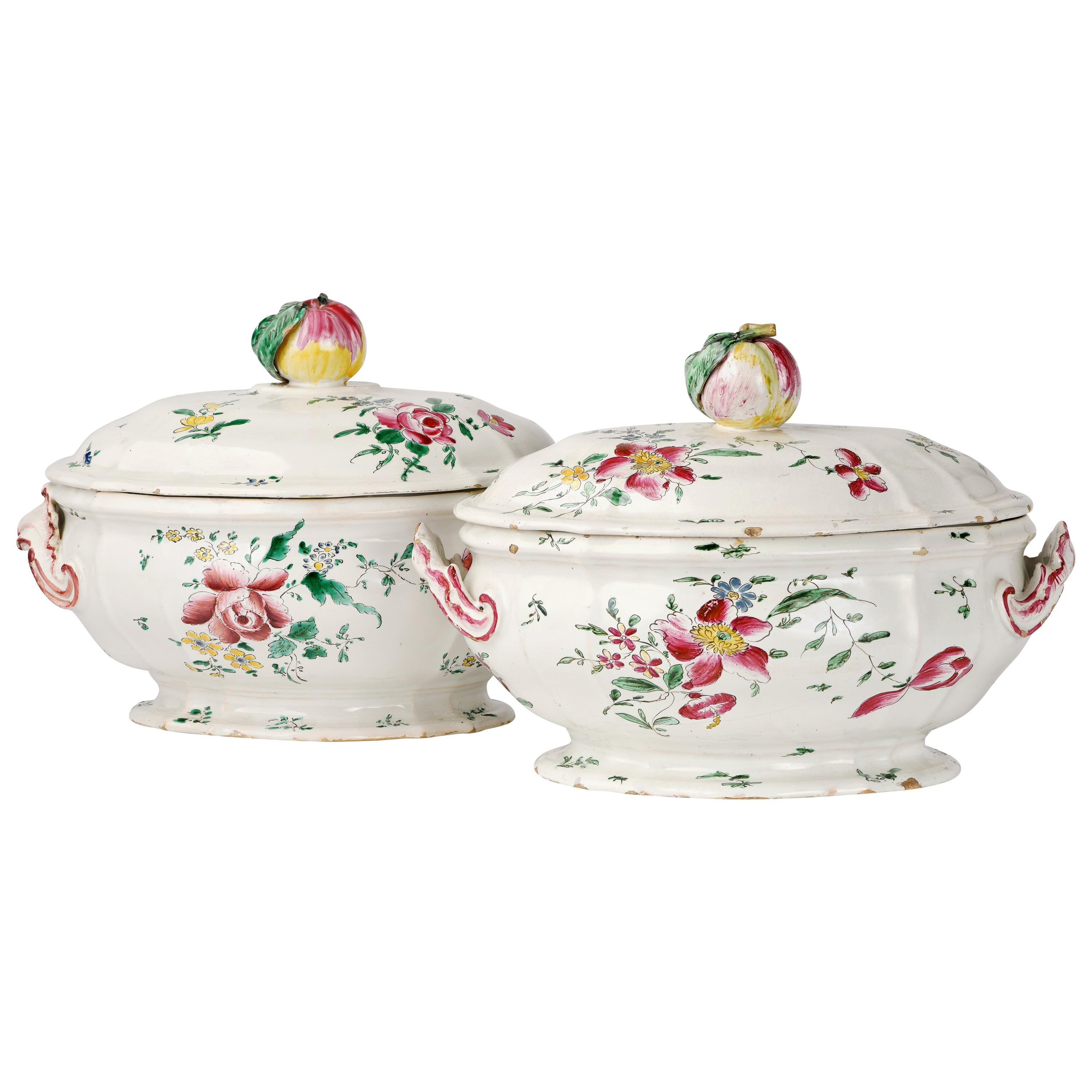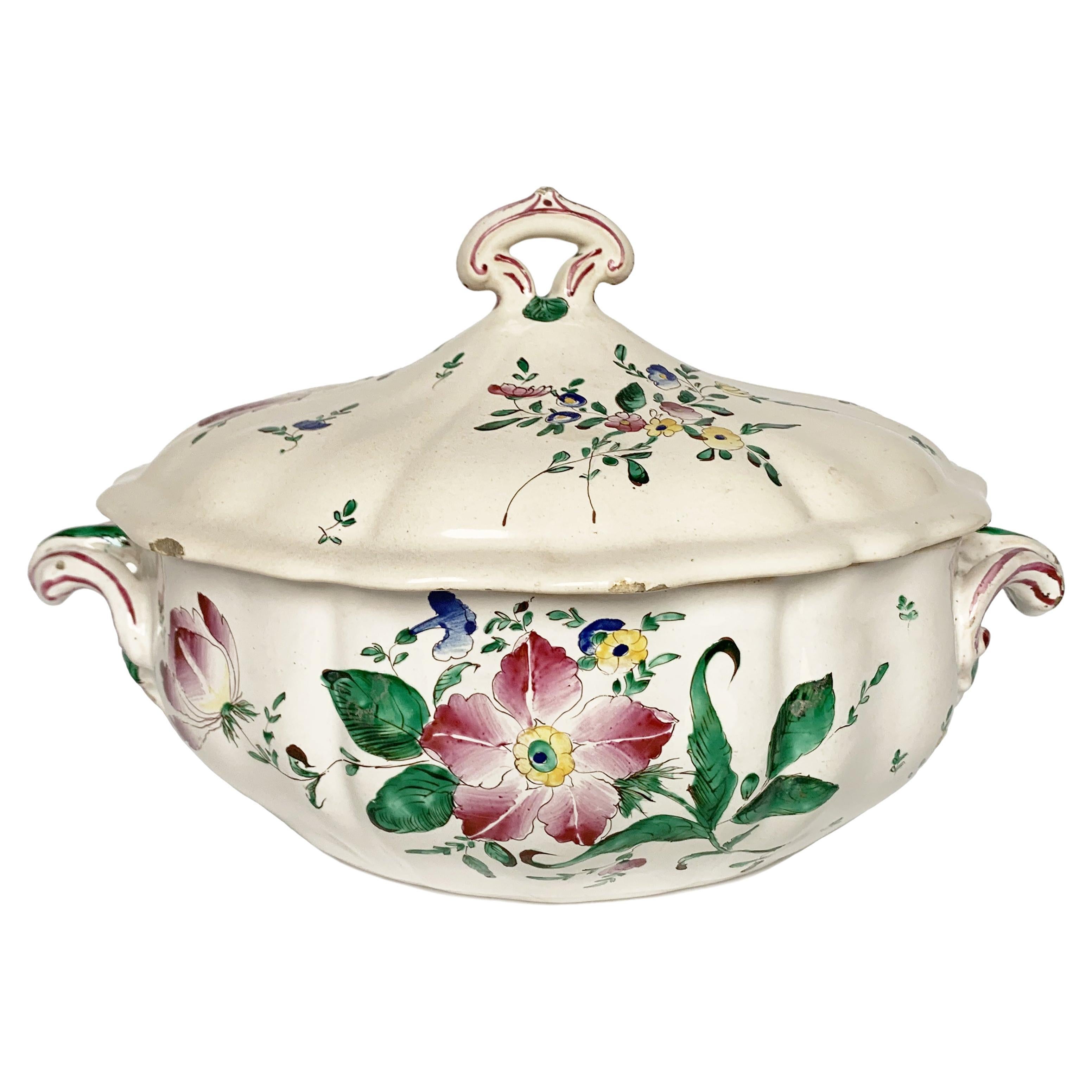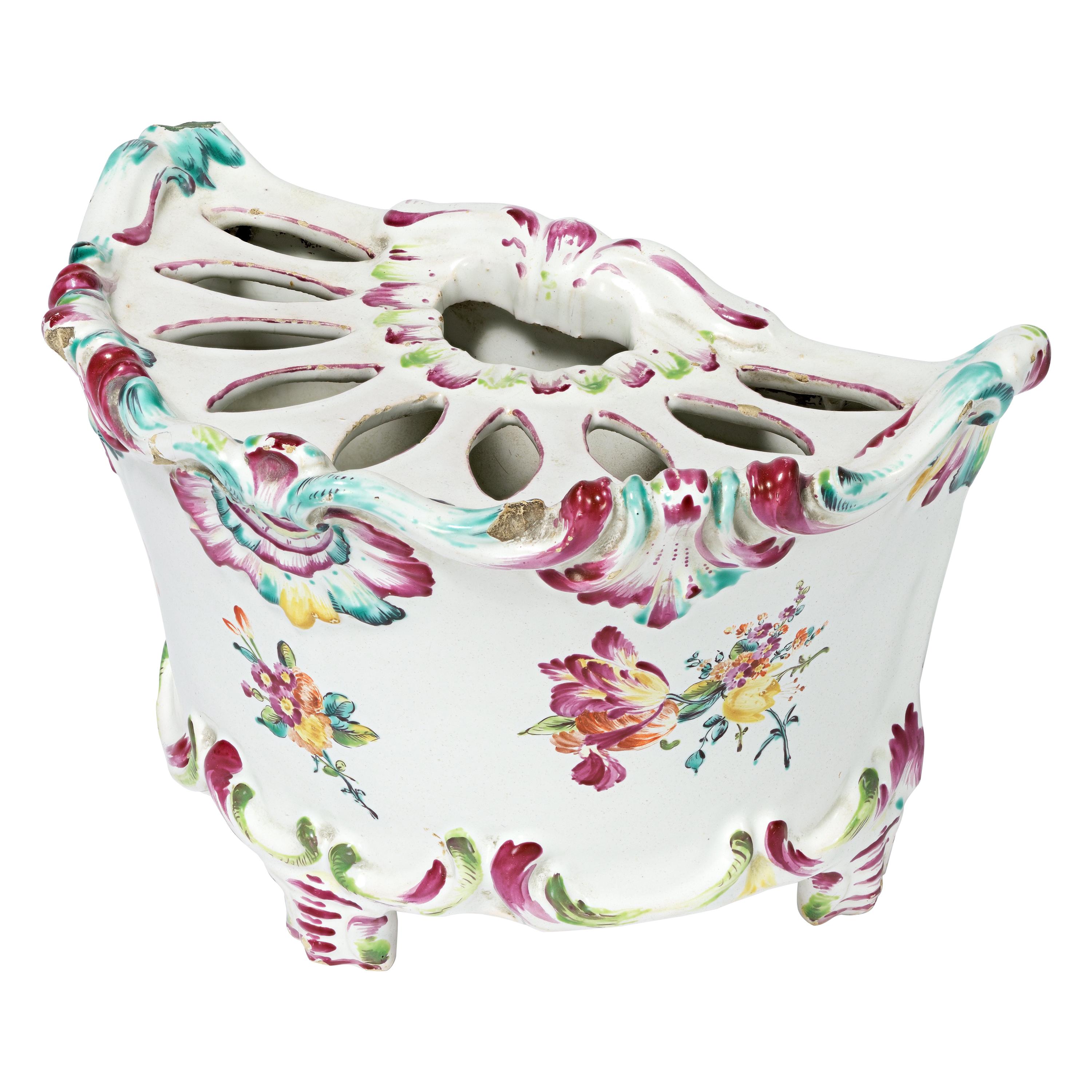Items Similar to Ancient Italian Maiolica Tureen Milano, 1770 circa
Video Loading
Want more images or videos?
Request additional images or videos from the seller
1 of 16
Ancient Italian Maiolica Tureen Milano, 1770 circa
About the Item
Maiolica tureen “allo struzzo” (ostrich decoration)
Milan, Felice Clerici or Pasquale Rubati factory, circa 1750-1780
Measures: 9.25 in x 12.79 in x 10.23 in (cm 23.5 x cm 32.5 x cm 26)
lb 4.78 (kg 2.17)
State of conservation, a felûre consolidated inside with slight edge chipping restored.
In Milan in the 18th century two Majolica warehouses were opened, the first, by Felice Clerici, in 1745, the second in 1756 by Pasquale Rubati.
Traditionally this type of decoration has been attributed to the Pasquale Rubati factory. In reality the motif “allo struzzo”, one of the clearest examples of how the taste for chinoiserie met with considerable success during the 18th century, had been produced, in specimens of greater or lesser quality, by both Milanese manufactories.
This Maiolica tureen has a swollen and ribbed oval bowl, rests on an extroflexed foot and shows stirrup handles.
The tri-color ornament, in the typical tones of Japanese "Imari" decorations, shows an idealized oriental landscape that develops around a perforated rock and has a willow tree with long lance-shaped leaves framing the long-legged bird figure. The ornamentation is enhanced by decorative elements such as butterflies, small florets and a vase with a thin flowery stem.
The lid is ribbed with a pear-shaped knob on top.
The decoration was called in the Milanese manufactories "allo struzzo" (ostrich decoration) and this refers to the oriental figure Xian He or the crane, symbol of longevity, here losing its symbolic value. It is hypothesized that among some 16th century engravings present in the Milanese factories there must also have been the famous engraving of the Maestro del Dado by Raffello Sanzio, in which three cherubs play with an ostrich, or perhaps we might recall the one depicting the ostrich hunt by Antonio Tempesta, such depictions may have influenced the definition of this decoration. (Ausenda, R. (a cura di), Musei e Gallerie di Milano. Museo d’Arti Applicate. Le ceramiche. Tomo secondo. Milano 2001, pp. 307-309 n. 309. Also for a similar assortment.)
Even the slightly blue colored enamel takes up the tones of oriental porcelain.
This type of ornament was such a great success that it was used on many forms and services and was offered to the 18th century public by both Milanese manufacturers (Ausenda 2001, p. 307, n. 309).
A very close comparison, albeit enriched by touches of gold, can be found in the Gianetti collection in Saronno (Ausenda R., a cura di, Ceramiche della collezione Gianetti, Milano 1996).
- Creator:Pasquale Rubati (Manufacturer),Felice Clerici (Manufacturer)
- Dimensions:Height: 9.26 in (23.5 cm)Width: 12.8 in (32.5 cm)Depth: 10.24 in (26 cm)
- Style:Chinoiserie (Of the Period)
- Materials and Techniques:Maiolica,Other
- Place of Origin:
- Period:1770-1779
- Date of Manufacture:circa 1770
- Condition:Repaired: A felûre consolidated inside with slight edge chipping restored. Wear consistent with age and use. A felûre consolidated inside with slight edge chipping restored.
- Seller Location:Milano, IT
- Reference Number:1stDibs: LU4352214038652
About the Seller
4.3
Vetted Seller
These experienced sellers undergo a comprehensive evaluation by our team of in-house experts.
Established in 1860
1stDibs seller since 2018
19 sales on 1stDibs
Typical response time: 1 hour
Associations
International Confederation of Art and Antique Dealers' Associations
- ShippingRetrieving quote...Ships From: Milano, Italy
- Return PolicyA return for this item may be initiated within 14 days of delivery.
More From This SellerView All
- Ancient Italian Maiolica Tureen, Rubati Manufacture, Milan, circa 1770-1780By Pasquale RubatiLocated in Milano, ITMaiolica tureen Pasquale Rubati Manufacture Milan, circa 1770 - 1780 Maiolica polychrome decorated “a piccolo fuoco” (third fire). It measures 6.69 in x 11,02 x 8.26 (17 x 28 x ...Category
Antique 1770s Italian Rococo Ceramics
MaterialsMaiolica
- Italian Maiolica Ancient Tureen, Lodi, 1770-1780By Antonio FerrettiLocated in Milano, ITMaiolica tureen Antonio Ferretti Manufacture Lodi, circa 1770-1780 Maiolica polychrome decorated “a piccolo fuoco” (third fire). It measures 9.05 x 12.59 x 9.05 in (23 x 32 x 23 cm) ...Category
Antique 1770s Italian Rococo Ceramics
MaterialsMaiolica
- Ancient Pair of Italian Maiolica Dishes Milano, circa 1770By Felice ClericiLocated in Milano, ITTwo maiolica dishes, "Famille Rose" decoration Felice Clerici Factory Milan, 1770-1780 9.13 in (23.2 cm) each in diameter lb 1.32 (kg 0.6) State of conservation: perfect, except for slight chipping at the edges The dishes are rare examples of a service produced by the factory of Felice Clerici (1710-1780) in Milan. Felice Clerici had opened his own factory in Milan in 1745, inserting himself into the new European stylistic trend which saw maiolica becoming a fine product like porcelain. The Milanese entrepreneur worked in the early period with high fire furnaces, declaring only in 1759 that he had purchased "the secrets of the paintings by force of money," by which he meant he now could obtain colors with a greater chromatic range with a low fire. The two dishes are funds with lightly blue glaze. Smooth barely detectable rim and ring foot. Along the edge there is a thin orange band with a chain of small spirals whereas along the brim there is a typical oriental decoration with peonies and chrysanthemums and minor florets. The flounce hosts a motif "in reserves" centered inside alternating flower and trellis motifs on pink and green backgrounds. In the center an oriental floral ornament is developed around a sturdy branch. On the back the "fraction" brand by Felice Clerici in black. Raffella Ausenda, while cataloging a maiolica in the same model as ours, conserved in the collections of the Museo di Arti Applicate del Castello in Milan (to which we refer for comparison), highlights that the ornamentation is directly inspired by Chinese porcelain from the Kang'hsi period known as "Famille Rose". The Clerici manufacture had in fact such a technical command of colors that it could perfectly imitate the oriental models even thanks to the aid of painters such as Giuseppe Sormani and Giacomo Facchetti who “painted with enamel in gold and silver colors. They imitate and accompany porcelain". The recent publication, edited by the same scholar (R. Ausenda in J.V.G. Mallet and E.P. Sani, a cura di, Maiolica in Italy and Beyond. pp. 124-140), underlines how the rebirth of maiolica in northern Italy also sprang from the experiences of the Milanese factory of Pasquale Rubati. This factory, established in 1756, obtained very high quality products, even considered among the best of the time. In the study she remarks how the pieces produced in the factory so closely matched Chinese...Category
Antique 1770s Italian Rococo Ceramics
MaterialsMaiolica
- Pair of Italian Maiolica Tureens, Ferretti Manufacture, Lodi Circa 1770 - 1780By Antonio FerrettiLocated in Milano, ITPair of maiolica tureens Antonio Ferretti Manufacture Lodi, circa 1770-1780 Maiolica polychrome decorated “a piccolo fuoco” (third fire). a – 8.66 x 11.02 x 7.48 in (22 x 28 x 19...Category
Antique 1770s Italian Rococo Ceramics
MaterialsMaiolica
- Ancient Maiolica Tureen Ferretti Manufacture, Lodi, Circa 1770 - 1780By Antonio FerrettiLocated in Milano, ITMaiolica tureen Antonio Ferretti Manufacture Lodi, Circa 1770 - 1780 Maiolica polychrome decorated “a piccolo fuoco” (third fire). It measures 9.06 in in height x 13.39 in x 9.84 i...Category
Antique 1770s Italian Rococo Soup Tureens
MaterialsMaiolica
- Rococo Italian Maiolica Flower Pot Pasquale Rubati, Milano, 1770 circaBy Pasquale RubatiLocated in Milano, ITMaiolica flower pot “a mezzaluna” with support feet decorated with little bunches of flowers Pasquale Rubati Factory Milan, circa 1770 5.5 in X ...Category
Antique 1770s Italian Rococo Ceramics
MaterialsMaiolica
You May Also Like
- Majolica Goose Tureen, circa 1950Located in Austin, TXBrown Majolica goose tureen signed on underside Caugant, circa 1950.Category
Vintage 1950s French Country Soup Tureens
MaterialsCeramic
- Majolica Doe Tureen Caugant, circa 1950By Michel CaugantLocated in Austin, TXRare Majolica doe tureen signed Caugant, circa 1950.Category
Vintage 1950s French Country Soup Tureens
MaterialsCeramic
- French Majolica Rabbit Tureen circa 1940By Michel CaugantLocated in Austin, TXFrench Majolica rabbit tureen, circa 1940 signed "Caugant.".Category
Vintage 1940s French Country Soup Tureens
MaterialsCeramic
- Majolica Bison Tureen Caugant, circa 1950By Michel CaugantLocated in Austin, TXMajolica bison tureen signed Michel Caugant, circa 1950.Category
Vintage 1950s French Rustic Ceramics
MaterialsCeramic
- Vintage Italian Ceramic Swan Soup TureenLocated in Pearland, TXA lovely Italian ceramic swan floral soup tureen. Maker's mark on reverse. This gorgeous tureen is in the form of a graceful swan with beautiful h...Category
Mid-20th Century Italian Soup Tureens
MaterialsCeramic
- Pair Porcelain Tureens Antique English Made circa 1840By Copeland SpodeLocated in Katonah, NYWe are pleased to offer this pair of English porcelain tureens painted with a striking chinoiserie decoration. They were made by Copeland Spode circa 1840. The decoration on these tu...Category
Antique 1840s English Qing Soup Tureens
MaterialsIronstone
Recently Viewed
View AllMore Ways To Browse
Oriental Italian
Ancient Ceramics
Italian Ceramics Blue
Antique Italian Ceramics
Ancient Birds
Antique Symbols On Silver
Oriental Ceramics
Oriental Porcelain
Antique Ribbed Glass
Antique Glass Knobs
Glass Knobs Antique
Antique Oriental Ceramics
Antique Oriental Porcelain
Antique Silver Knobs
Blue Tureen
Silver Enamel Figure
Hunt Motif
Butterfly Glasses Frames





